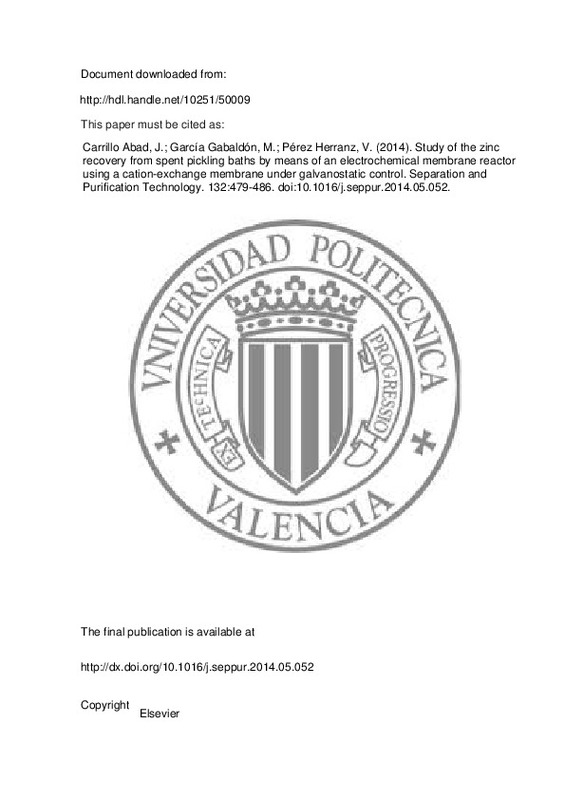JavaScript is disabled for your browser. Some features of this site may not work without it.
Buscar en RiuNet
Listar
Mi cuenta
Estadísticas
Ayuda RiuNet
Admin. UPV
Study of the zinc recovery from spent pickling baths by means of an electrochemical membrane reactor using a cation-exchange membrane under galvanostatic control
Mostrar el registro sencillo del ítem
Ficheros en el ítem
| dc.contributor.author | Carrillo Abad, Jordi
|
es_ES |
| dc.contributor.author | García Gabaldón, Montserrat
|
es_ES |
| dc.contributor.author | Pérez Herranz, Valentín
|
es_ES |
| dc.date.accessioned | 2015-05-11T09:45:33Z | |
| dc.date.available | 2015-05-11T09:45:33Z | |
| dc.date.issued | 2014-08-20 | |
| dc.identifier.issn | 1383-5866 | |
| dc.identifier.uri | http://hdl.handle.net/10251/50009 | |
| dc.description.abstract | The performance of a cation-exchange membrane (CEM) used for recovering zinc from real spent pickling baths is studied in this work. These spent baths contain high amounts of ZnCl2 and FeCl2 in aqueous HCl media. The results obtained with this membrane are compared with those obtained with an anion-exchange membrane (AEM) treating the same effluent. The effect of the presence or absence of initial zinc in the cathodic compartment is also studied. The absence of initial zinc in the cathodic compartment in the CEM experiments permits iron codeposition. Furthermore, the results obtained with the CEM are worse than those obtained with the AEM for all the figures of merit. This fact shows the need of filling the cathodic compartment with a synthetic zinc solution. The presence of zinc in the cathodic compartment from the beginning of the electrolysis not only inhibits iron codeposition but also favors zinc deposition as the hydrogen evolution reaction becomes a secondary reaction, improving by this way the results of all the figures of merit of the reactor with the CEM. A deep study about the effect of the applied current and the concentration of the synthetic zinc solution placed in the cathodic compartment permits to reach the equilibrium between the zinc transferred through the membrane and that deposited on the cathode. Therefore, the synthetic cathodic zinc is not consumed at any time. Moreover, under this circumstances iron codeposition is also avoided. | es_ES |
| dc.description.sponsorship | The authors want to express their gratitude to the Generalitat Valenciana for a postgraduate Grant (GV/2010/029) and to the Ministerio de Economia y Competitividad for financing the project number CTQ2012-37450-C02-01/PPQ. | en_EN |
| dc.language | Inglés | es_ES |
| dc.publisher | Elsevier | es_ES |
| dc.relation.ispartof | Separation and Purification Technology | es_ES |
| dc.rights | Reserva de todos los derechos | es_ES |
| dc.subject | Anion-exchange membrane | es_ES |
| dc.subject | Cation-exchange membrane | es_ES |
| dc.subject | Iron codeposition Pickling solutions | es_ES |
| dc.subject | Pickling solutions | es_ES |
| dc.subject | Zinc electrodeposition | es_ES |
| dc.subject.classification | INGENIERIA QUIMICA | es_ES |
| dc.title | Study of the zinc recovery from spent pickling baths by means of an electrochemical membrane reactor using a cation-exchange membrane under galvanostatic control | es_ES |
| dc.type | Artículo | es_ES |
| dc.identifier.doi | 10.1016/j.seppur.2014.05.052 | |
| dc.relation.projectID | info:eu-repo/grantAgreement/GVA//GV%2F2010%2F029/ | es_ES |
| dc.relation.projectID | info:eu-repo/grantAgreement/MINECO//CTQ2012-37450-C02-01/ES/CARACTERIZACION ELECTROQUIMICA DE MEMBRANAS CERAMICAS NANOESTRUCTURADAS DE INTERCAMBIO IONICO PARA SU APLICACION EN REACTORES ELECTROQUIMICOS Y SISTEMAS ELECTRODIALITICOS/ | es_ES |
| dc.rights.accessRights | Abierto | es_ES |
| dc.contributor.affiliation | Universitat Politècnica de València. Departamento de Ingeniería Química y Nuclear - Departament d'Enginyeria Química i Nuclear | es_ES |
| dc.description.bibliographicCitation | Carrillo Abad, J.; García Gabaldón, M.; Pérez Herranz, V. (2014). Study of the zinc recovery from spent pickling baths by means of an electrochemical membrane reactor using a cation-exchange membrane under galvanostatic control. Separation and Purification Technology. 132:479-486. https://doi.org/10.1016/j.seppur.2014.05.052 | es_ES |
| dc.description.accrualMethod | S | es_ES |
| dc.relation.publisherversion | http://dx.doi.org/10.1016/j.seppur.2014.05.052 | es_ES |
| dc.description.upvformatpinicio | 479 | es_ES |
| dc.description.upvformatpfin | 486 | es_ES |
| dc.type.version | info:eu-repo/semantics/publishedVersion | es_ES |
| dc.description.volume | 132 | es_ES |
| dc.relation.senia | 271871 | |
| dc.identifier.eissn | 1873-3794 | |
| dc.contributor.funder | Generalitat Valenciana | es_ES |
| dc.contributor.funder | Ministerio de Economía y Competitividad | es_ES |







![[Cerrado]](/themes/UPV/images/candado.png)

